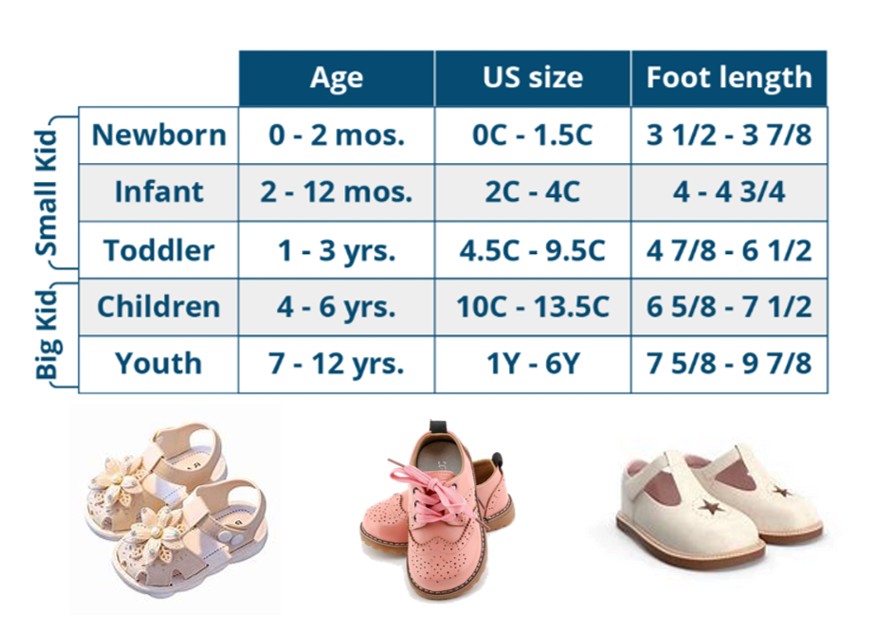Kids Shoe Size Chart
| Length (inches) | Length (inches) | Length (CM) | US Size | UK Size | Euro Size | JPN Size |
|---|---|---|---|---|---|---|
| 5" | 5" | 12.7 cm | 5.5 | 4.5 | 21 | 13.5 |
| 5 1/8" | 5.125" | 13 cm | 6 | 5 | 22 | 14 |
| 5 1/4" | 5.25" | 13.3 cm | 6.5 | 5.5 | 22 | 14 / 14.5 |
| 5 1/2" | 5.5" | 14 cm | 7 | 6 | 23 | 14.5 |
| 5 5/8" | 5.625" | 14.3 cm | 7.5 | 6.5 | 23 | 14.5 / 15 |
| 5 3/4" | 5.75" | 14.6 cm | 8 | 7 | 24 | 15 |
| 6" | 6" | 15.2 cm | 8.5 | 7.5 | 25 | 15 / 15.5 |
| 6 1/8" | 6.125" | 15.6 cm | 9 | 8 | 25 | 15.5 |
| 6 1/4" | 6.25" | 15.9 cm | 9.5 | 8.5 | 26 | 16 |
| 6 1/2" | 6.5" | 16.5 cm | 10 | 9 | 27 | 16.5 |
| 6 5/8" | 6.625" | 16.8 cm | 10.5 | 9.5 | 27 | 16.5 / 17 |
| 6 3/4" | 6.75" | 17.1 cm | 11 | 10 | 28 | 17 |
| 7" | 7" | 17.8 cm | 11.5 | 10.5 | 29 | 17 / 17.5 |
| 7 1/8" | 7.125" | 18.1 cm | 12 | 11 | 30 | 17.5 |
| Kids Shoe Size Chart Maker : iSizeChart.com | ||||||
About Kids & Child Shoe Size Guide Chart
How to choose a suitable kids shoe ?
1. Consider the Child’s Age and Foot Development Stage.
Preschoolers (3-5 years): Look for shoes with good arch support and cushioning as they become more active. Prioritize breathable materials to prevent sweat and odor.
School-Age Kids (6+ years): Select shoes designed for specific activities (e.g., sports shoes for athletics, sturdy shoes for outdoor play). Ensure proper arch support and shock absorption for growing feet.
2. Prioritize Fit and comfort.
Allow Room for Growth: Leave about a thumb’s width (½ inch or 1.25 cm) between the longest toe and the shoe’s tip. Avoid shoes that are too tight, as they can restrict growth and cause discomfort.
Check Width and Depth: Ensure the shoe isn’t too narrow or shallow, which can squeeze toes or cause blisters. The shoe should fit snugly around the heel without slipping.
3. Choose the Right Material.
Flexible Soles: The sole should bend easily at the ball of the foot to mimic natural walking motion. Avoid hard, stiff soles that restrict movement.
Durable Construction: Look for reinforced stitching and sturdy materials, especially for active kids.
4. Look for Proper Support and Cushioning.
Cushioned Insoles: Soft, padded insoles absorb shock and reduce fatigue during walking or running.
Heel Support: A firm heel counter (the back part of the shoe) helps stabilize the foot and ankle.
5. Check for Safety Features.
Secure Closures: Velcro, laces, or buckles ensure the shoe stays on during play and provides a customizable fit.
Avoid Choking Hazards: Ensure decorations (like buttons or bows) are securely attached and won’t come off easily.
6. Consider the Activity and Environment.
Sports and Physical Activities: Select sport-specific shoes (e.g., running shoes for track, cleats for soccer) for proper support and injury prevention.
Weather Conditions: For rain or snow, opt for waterproof or water-resistant shoes with good traction.
7. Involve Your Child in the Decision.
Allow them to choose from a few options to encourage independence and ensure they’ll wear the shoes happily.
8. Regularly Check for Fit.
NKids’ feet grow quickly, so measure their feet every few months and replace shoes as needed.
